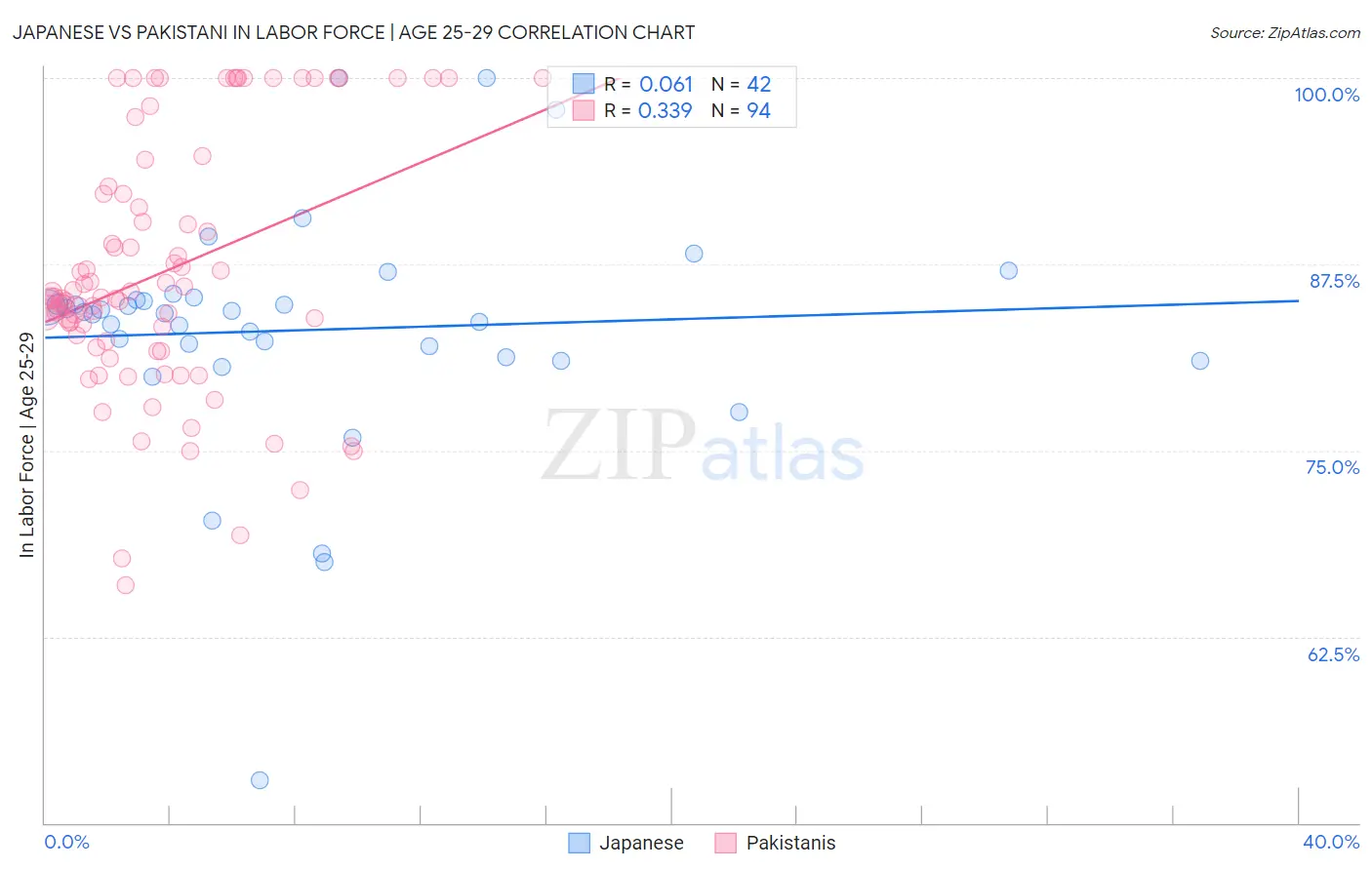Japanese vs Pakistani In Labor Force | Age 25-29
COMPARE
Japanese
Pakistani
In Labor Force | Age 25-29
In Labor Force | Age 25-29 Comparison
Japanese
Pakistanis
84.3%
IN LABOR FORCE | AGE 25-29
11.4/ 100
METRIC RATING
213th/ 347
METRIC RANK
84.8%
IN LABOR FORCE | AGE 25-29
70.0/ 100
METRIC RATING
142nd/ 347
METRIC RANK
Japanese vs Pakistani In Labor Force | Age 25-29 Correlation Chart
The statistical analysis conducted on geographies consisting of 249,141,498 people shows a slight positive correlation between the proportion of Japanese and labor force participation rate among population between the ages 25 and 29 in the United States with a correlation coefficient (R) of 0.061 and weighted average of 84.3%. Similarly, the statistical analysis conducted on geographies consisting of 335,283,437 people shows a mild positive correlation between the proportion of Pakistanis and labor force participation rate among population between the ages 25 and 29 in the United States with a correlation coefficient (R) of 0.339 and weighted average of 84.8%, a difference of 0.54%.

In Labor Force | Age 25-29 Correlation Summary
| Measurement | Japanese | Pakistani |
| Minimum | 52.9% | 66.0% |
| Maximum | 100.0% | 100.0% |
| Range | 47.1% | 34.0% |
| Mean | 83.1% | 87.0% |
| Median | 84.3% | 85.2% |
| Interquartile 25% (IQ1) | 81.3% | 82.3% |
| Interquartile 75% (IQ3) | 85.1% | 92.2% |
| Interquartile Range (IQR) | 3.8% | 9.9% |
| Standard Deviation (Sample) | 8.0% | 8.4% |
| Standard Deviation (Population) | 7.9% | 8.3% |
Similar Demographics by In Labor Force | Age 25-29
Demographics Similar to Japanese by In Labor Force | Age 25-29
In terms of in labor force | age 25-29, the demographic groups most similar to Japanese are Subsaharan African (84.3%, a difference of 0.0%), Lebanese (84.3%, a difference of 0.010%), Immigrants from Syria (84.3%, a difference of 0.010%), Immigrants from Jordan (84.4%, a difference of 0.020%), and Chinese (84.3%, a difference of 0.020%).
| Demographics | Rating | Rank | In Labor Force | Age 25-29 |
| Immigrants | Cambodia | 14.3 /100 | #206 | Poor 84.4% |
| Immigrants | Armenia | 13.3 /100 | #207 | Poor 84.4% |
| Immigrants | Indonesia | 13.2 /100 | #208 | Poor 84.4% |
| Immigrants | Jordan | 12.8 /100 | #209 | Poor 84.4% |
| Chinese | 12.7 /100 | #210 | Poor 84.3% |
| Immigrants | Venezuela | 12.6 /100 | #211 | Poor 84.3% |
| Sub-Saharan Africans | 11.7 /100 | #212 | Poor 84.3% |
| Japanese | 11.4 /100 | #213 | Poor 84.3% |
| Lebanese | 11.1 /100 | #214 | Poor 84.3% |
| Immigrants | Syria | 10.7 /100 | #215 | Poor 84.3% |
| Israelis | 9.3 /100 | #216 | Tragic 84.3% |
| Immigrants | Ecuador | 9.3 /100 | #217 | Tragic 84.3% |
| Immigrants | Nigeria | 9.0 /100 | #218 | Tragic 84.3% |
| Immigrants | Saudi Arabia | 8.8 /100 | #219 | Tragic 84.3% |
| Nigerians | 7.2 /100 | #220 | Tragic 84.3% |
Demographics Similar to Pakistanis by In Labor Force | Age 25-29
In terms of in labor force | age 25-29, the demographic groups most similar to Pakistanis are Sri Lankan (84.8%, a difference of 0.010%), Immigrants from Laos (84.8%, a difference of 0.010%), Immigrants from Senegal (84.8%, a difference of 0.010%), Armenian (84.8%, a difference of 0.020%), and Immigrants from Eastern Asia (84.8%, a difference of 0.020%).
| Demographics | Rating | Rank | In Labor Force | Age 25-29 |
| Immigrants | Hungary | 76.4 /100 | #135 | Good 84.8% |
| Bhutanese | 76.0 /100 | #136 | Good 84.8% |
| Immigrants | Canada | 73.5 /100 | #137 | Good 84.8% |
| Armenians | 72.7 /100 | #138 | Good 84.8% |
| Immigrants | Eastern Asia | 72.6 /100 | #139 | Good 84.8% |
| Immigrants | North America | 72.1 /100 | #140 | Good 84.8% |
| Danes | 71.9 /100 | #141 | Good 84.8% |
| Pakistanis | 70.0 /100 | #142 | Good 84.8% |
| Sri Lankans | 69.2 /100 | #143 | Good 84.8% |
| Immigrants | Laos | 69.0 /100 | #144 | Good 84.8% |
| Immigrants | Senegal | 68.3 /100 | #145 | Good 84.8% |
| Icelanders | 68.2 /100 | #146 | Good 84.8% |
| Immigrants | Asia | 68.2 /100 | #147 | Good 84.8% |
| Immigrants | England | 65.2 /100 | #148 | Good 84.7% |
| Peruvians | 64.7 /100 | #149 | Good 84.7% |